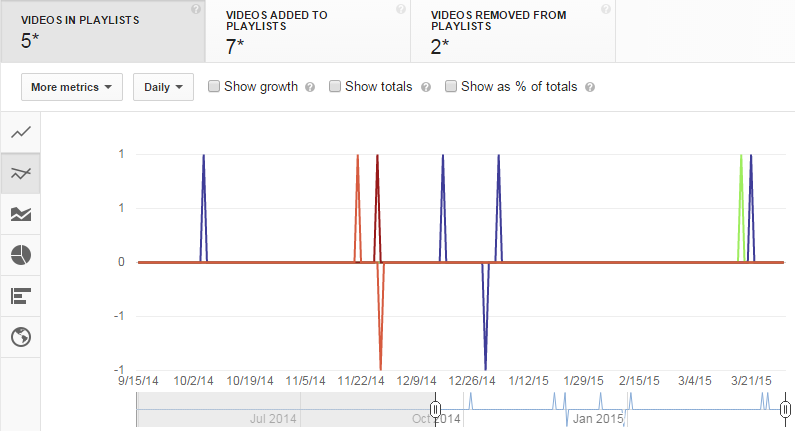In addition to Cards, YouTube has rolled out a new analytics feature, videos in playlists, for creators to better understand the reach of their videos. Currently a general metric, don’t be surprised to find greater depth down the road when feedback is implemented.
What Are “Videos in Playlists?”
This metric counts the total number of times your videos have been included to playlists created by other YouTube users. This number changes; it’s a running figure of videos added to playlists minus videos removed from playlists. Video playlists may be public (openly viewable by anybody) or private based on the author’s privacy settings.
You’re able to see which videos have been added or subtracted from other playlists by title. Clicking on a title shows you a breakdown by “Geography” (e.g. United States) and “Date.” Unfortunately, you’re currently unable to drill-down any deeper to pinpoint exact locations (i.e. states, cities) or times (e.g. morning, afternoon, evening).

Graphs like the line chart display additions and subtractions by date based on the time frame you choose (e.g. lifetime usage, last month, last quarter, 90 days, last year). The multi-line chart refines this data to include country/region information along with the action date. In other words, you can know that a YouTuber from Canada added your video about (insert topic) on January 31st, 2015. You’ll also know when someone from (insert region) removes one of your videos from a playlist.
What It Means for Your YouTube Marketing
It’s no secret that watch time per session is the leading ranking factor in YouTube’s algorithm. Prominent rankings can mean great visibility for your videos not only in YouTube but Google’s universal search listings. An excellent starting position + insightful content = a recipe for building authority for your brand and interest in your value propositions.
Mark R. Robertson of ReelSEO cuts to the heart of the matter (emphasis ours):
High completion rates for individual videos are important. But for YouTube, Watch Time per user session is what YouTube is favoring in their algorithm. What does this mean? Well, again, YouTube’s goal is to keep viewers on YouTube and keep them satisfied.
Therefore, Watch Time is NOT simply how much of your video was watched, rather it is a measure of how much your video contributed to a users’ overall time watching videos on the site.
Playlist activity reflects engagement among some of the most active and “video fluent” of your YouTube audiences. These viewers are curating content and creating their own customized solution sets for certain problems.
Remember, you’re competing for attention spans and dollars in these playlists from neutral viewers (i.e. those people who aren’t already loyal to you or your competitors). More than ever, YouTube marketers need to continually create awesome, valuable video content that is replayed and shared.
What You Can Do
1) Track playlist information
Research what other types of content shows alongside your video inside these playlists. What are your competitors crafting? What makes their offerings persuasive? Researching public playlists that contain your videos reveals fundamental needs and wants addressed by your content and your competitors. Paying attention to each video’s content structure and description will better educate you on the terminology and keywords viewers use when articulating their pain points. You can easily implement these findings in website’s structural design, the language of your copy, and the formatting of your videos to make your offerings more empathetic to your customers.
2) Reach out to thought leaders
Videos in playlists serve as a branding opportunity and discovery tool for a segment of YouTubers. This interaction is built on social proof, the “concept that people will conform to the actions of others under the assumption that those actions are reflective of the correct behavior” (h/t Buffer’s Ed Hallen), with the theory that a little bit of credibility is added with each curator’s approval (re: adding your videos in playlists). Thus, a lot of helpful information is at stake:
- Who is curating your videos?
- Are they related to your industry?
- What roles do they serve?
- What problems are they addressing?
- What types of videos are they adding?
- Where in the funnel are these videos?
- How long are these videos?
- What style/setups are preferred?
Consider inviting thought-leaders to video Q&A sessions on conferencing platforms like Google Hangout or Skype. Solicit their feedback and invite them to collaborate on future content. Communicate with these thought leaders (who) to find out why they found your video valuable, how they found you, and when they took action. These breakthroughs will inform you on where buyer personas are and what valuable content you should produce next.
3) Create follow-up content
Your research has led to a mountain of new insights. So, what can do you?
Create more valuable content for these needs! If you notice certain themes repeating in several playlists, consider producing:
- A series of blog posts with supplementary and complementary videos
- Case studies and/or white papers highlighting solutions
- Video testimonials
- Longer-form tutorials
- Topic-specific webinars
Knowing these buyer personas leads authoring more meaningful material for these audiences. This reduces friction along their journey and increases conversions for you.



